
The ovary is an organ found in the female reproductive system that produces an ovum. When released, this travels down the fallopian tube into the uterus, where it may become fertilized by a sperm. There is an ovary found on each side of the body. The ovaries also secrete hormones that play a role in the menstrual cycle and fertility. The ovary progresses through many stages beginning in the prenatal period through menopause. It is also an endocrine gland because of the various hormones that it secretes.
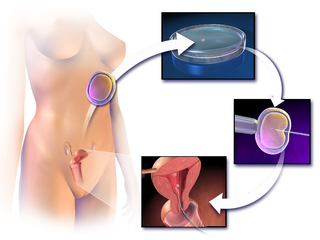
In vitro fertilisation (IVF) is a process of fertilisation where an egg is combined with sperm outside the body, in vitro. The process involves monitoring and stimulating a woman's ovulatory process, removing an ovum or ova from the woman's ovaries and letting sperm fertilise them in a liquid in a laboratory. After the fertilised egg (zygote) undergoes embryo culture for 2–6 days, it is implanted in the same or another woman's uterus, with the intention of establishing a successful pregnancy.
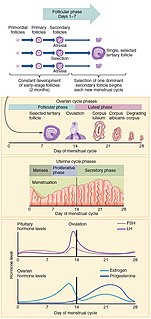
The menstrual cycle is the regular natural change that occurs in the female reproductive system that makes pregnancy possible. The cycle is required for the production of oocytes, and for the preparation of the uterus for pregnancy. The menstrual cycle occurs due to the rise and fall of estrogen. This cycle results in the thickening of the lining of the uterus, and the growth of an egg,. The egg is released from an ovary around day fourteen in the cycle; the thickened lining of the uterus provides nutrients to an embryo after implantation. If pregnancy does not occur, the lining is released in what is known as menstruation or a "period".
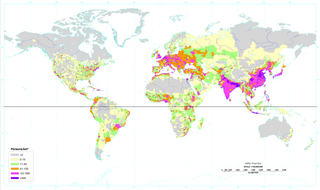
Population density is a measurement of population per unit area, or exceptionally unit volume; it is a quantity of type number density. It is frequently applied to living organisms, most of the time to humans. It is a key geographical term. In simple terms, population density refers to the number of people living in an area per square kilometre.
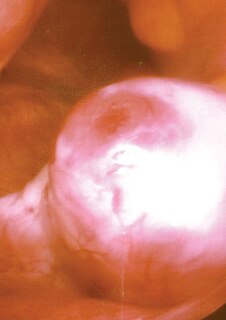
Ovulation is the release of eggs from the ovaries. In women, this event occurs when the ovarian follicles rupture and release the secondary oocyte ovarian cells. After ovulation, during the luteal phase, the egg will be available to be fertilized by sperm. In addition, the uterine lining (endometrium) is thickened to be able to receive a fertilized egg. If no conception occurs, the uterine lining as well as blood will be shed during menstruation.
Infertility is the inability of a person, animal or plant to reproduce by natural means. It is usually not the natural state of a healthy adult, except notably among certain eusocial species.
In demography, demographic transition is a phenomenon and theory which refers to the historical shift from high birth rates and high infant death rates in societies with minimal technology, education and economic development, to low birth rates and low death rates in societies with advanced technology, education and economic development, as well as the stages between these two scenarios. Although this shift has occurred in many industrialized countries, the theory and model are frequently imprecise when applied to individual countries due to specific social, political and economic factors affecting particular populations.
Fertility is the natural capability to produce offspring. As a measure, fertility rate is the number of offspring born per mating pair, individual or population. Fertility differs from fecundity, which is defined as the potential for reproduction A lack of fertility is infertility while a lack of fecundity would be called sterility.

The total fertility rate (TFR), sometimes also called the fertility rate, absolute/potential natality, period total fertility rate (PTFR), or total period fertility rate (TPFR) of a population is the average number of children that would be born to a woman over her lifetime if:
- She was to experience the exact current age-specific fertility rates (ASFRs) through her lifetime, and
- She was to survive from birth to the end of her reproductive life.

Sub-replacement fertility is a total fertility rate (TFR) that leads to each new generation being less populous than the older, previous one in a given area. In developed countries sub-replacement fertility is any rate below approximately 2.1 children born per woman, but the threshold can be as high as 3.4 in some developing countries because of higher mortality rates. Taken globally, the total fertility rate at replacement was 2.33 children per woman in 2003. This can be "translated" as 2 children per woman to replace the parents, plus a "third of a child" to make up for the higher probability of boys born and mortality prior to the end of a person's fertile life.
Fertility medication, better known as fertility drugs, are drugs which enhance reproductive fertility. For women, fertility medication is used to stimulate follicle development of the ovary. There are currently very few fertility medication options available for men.

The American Society for Reproductive Medicine (ASRM) is a non-profit, multidisciplinary organization dedicated to the advancement of the science and practice of reproductive medicine. The society has its headquarters in Birmingham, AL and a public affairs office in Washington, DC.

Human reproduction is any form of sexual reproduction resulting in human fertilization. It typically involves sexual intercourse between a man and a woman. During sexual intercourse, the interaction between the male and female reproductive systems results in fertilization of the woman's ovum by the man's sperm. These are specialized reproductive cells called gametes, created in a process called meiosis. While normal cells contains 46 chromosomes, 23 pairs, gamete cells only contain 23 chromosomes, and it is when these two cells merge into one zygote cell that genetic recombination occurs and the new zygote contains 23 chromosomes from each parent, giving them 23 pairs. A typical 9-month gestation period is followed by childbirth. The fertilization of the ovum may be achieved by artificial insemination methods, which do not involve sexual intercourse. Assisted reproductive technology also exists.
Advanced maternal age, in a broad sense, is the instance of a woman being of an older age at a stage of reproduction, although there are various definitions of specific age and stage of reproduction. The variability in definitions is in part explained by the effects of increasing age occurring as a continuum rather than as a threshold effect.
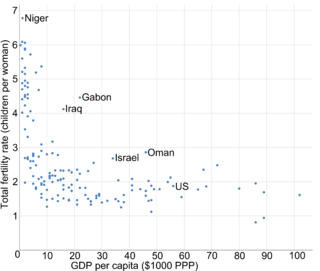
Income and fertility is the association between monetary gain on one hand, and the tendency to produce offspring on the other. There is generally an inverse correlation between income and the total fertility rate within and between nations. The higher the degree of education and GDP per capita of a human population, subpopulation or social stratum, the fewer children are born in any industrialized country. In a 1974 UN population conference in Bucharest, Karan Singh, a former minister of population in India, illustrated this trend by stating "Development is the best contraceptive."
Reproductive endocrinology and infertility (REI) is a surgical subspecialty of obstetrics and gynecology that trains physicians in reproductive medicine addressing hormonal functioning as it pertains to reproduction as well as the issue of infertility. While most REI specialists primarily focus on the treatment of infertility, reproductive endocrinologists are trained to also test and treat hormonal dysfunctions in females and males outside infertility. Reproductive endocrinologists have specialty training (residency) in obstetrics and gynecology (ob-gyn) before they undergo sub-specialty training (fellowship) in REI.
The relationship between fertility and intelligence has been investigated in many demographic studies. There is evidence that, on a population level, intelligence is negatively correlated with fertility rate and positively correlated with survival rate of offspring. The combined net effect of these two conflicting forces on ultimate population intelligence is not well studied and is unclear. It is theorized that if an inverse correlation of IQ with fertility rate were stronger than the correlation of IQ with survival rate, assuming this continued over a significant number of generations, it could lead to a decrease in population IQ scores. The Flynn effect demonstrates an increase in phenotypic IQ scores over time, but confounding environmental factors during the same period of time preclude any conclusion concerning underlying change in genotypic IQ. Other correlates of IQ include income and educational attainment, which are also fertility factors that are inversely correlated with fertility rate, and are to some degree heritable. Although fertility measures offspring per woman, if one needs to predict population-level changes, the average age of motherhood also needs to be considered, with lower age of motherhood potentially having a greater effect than fertility rate.
Unified growth theory was developed in light of the failure of endogenous growth theory to capture key empirical regularities in the growth processes and their contribution to the momentous rise in inequality across nations in the past two centuries. Unlike earlier growth theories that have focused entirely on the modern growth regime, unified growth theory captures the growth process over the entire course of human existence, highlighting the critical role of the differential timing of the transition from Malthusian stagnation to sustained economic growth in the emergence of inequality across countries and regions.
The following outline is provided as an overview of and topical guide to obstetrics:

William A. Albrecht (1888–1974) chairman of the Department of Soils at the University of Missouri, was the foremost authority on the relation of soil fertility to human health and earned four degrees from the University of Illinois at Urbana–Champaign. As emeritus professor of soils at the University of Missouri, he saw a direct link between soil quality, food quality and human health. He drew direct connections between poor quality forage crops, and ill health in livestock and from this developed a formula for ideal ratios of cations in the soil, the Base Cation Saturation Ratio. While he did not discover cation exchange in the soil as is sometimes supposed, he may have been the first to associate it with colloidal clay particles. He served as 1939 President of the Soil Science Society of America.
Twenty years before the phrase 'environmental concern' crept into the national consciousness, he was lecturing from coast to coast on the broad topic of agricultural ecology.
" The soil is the ‘creative material’ of most of the basic needs of life. Creation starts with a handful of dust.” Dr. William A. Abrecht.









